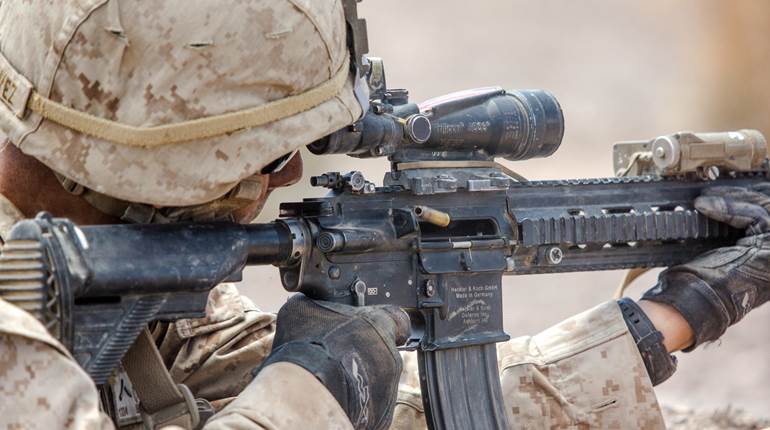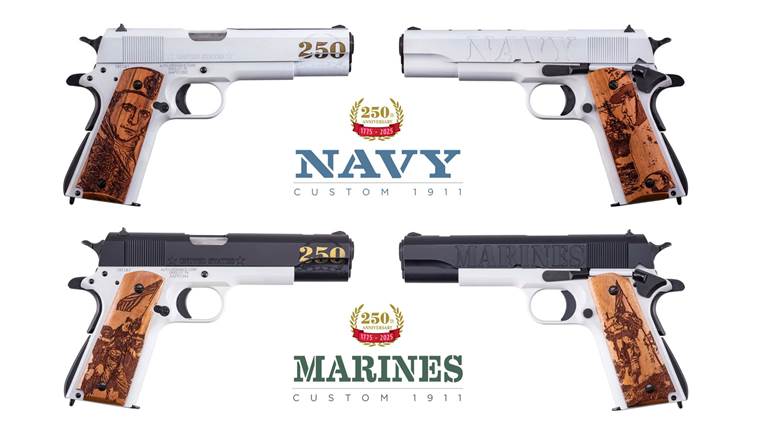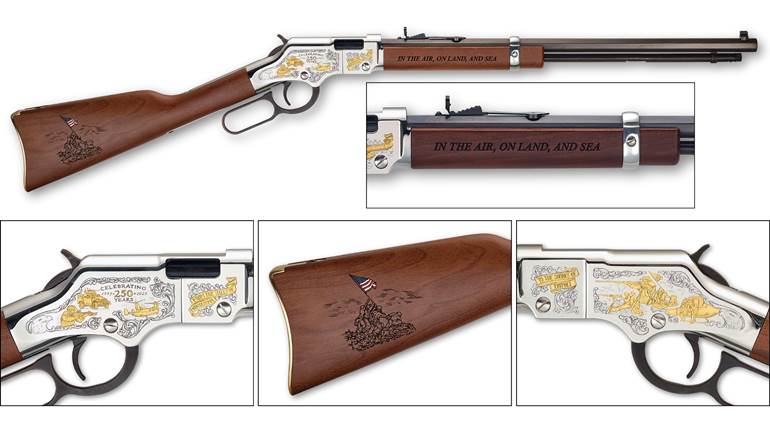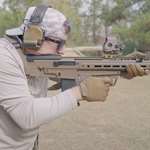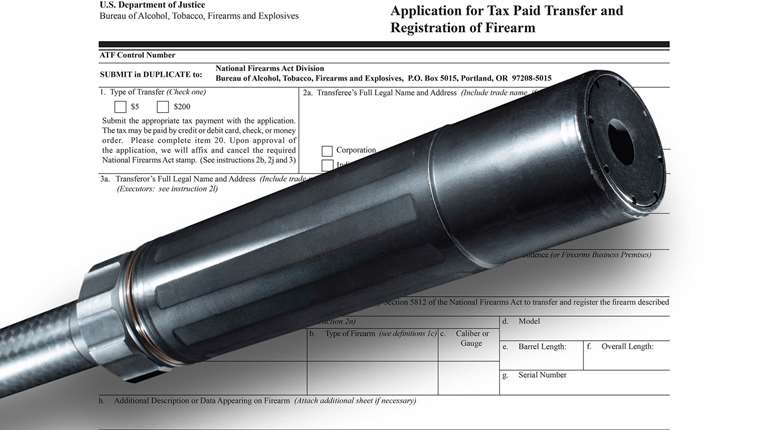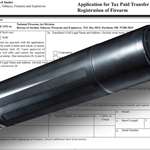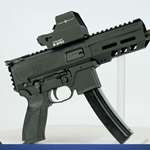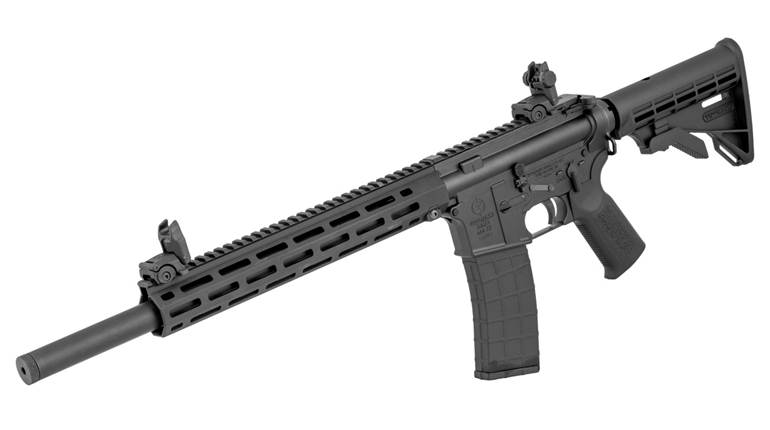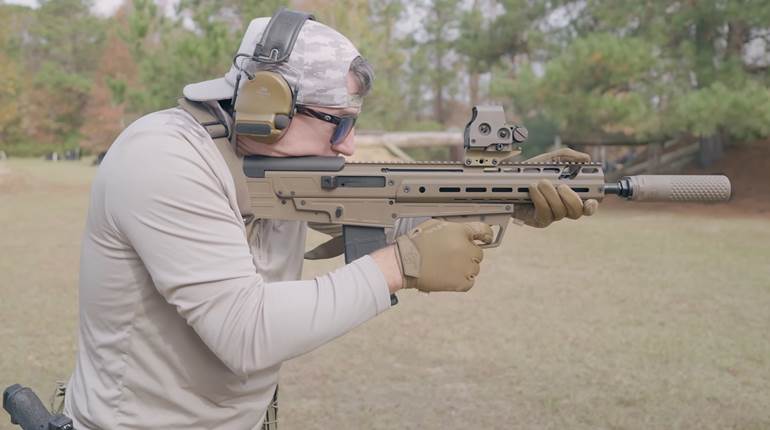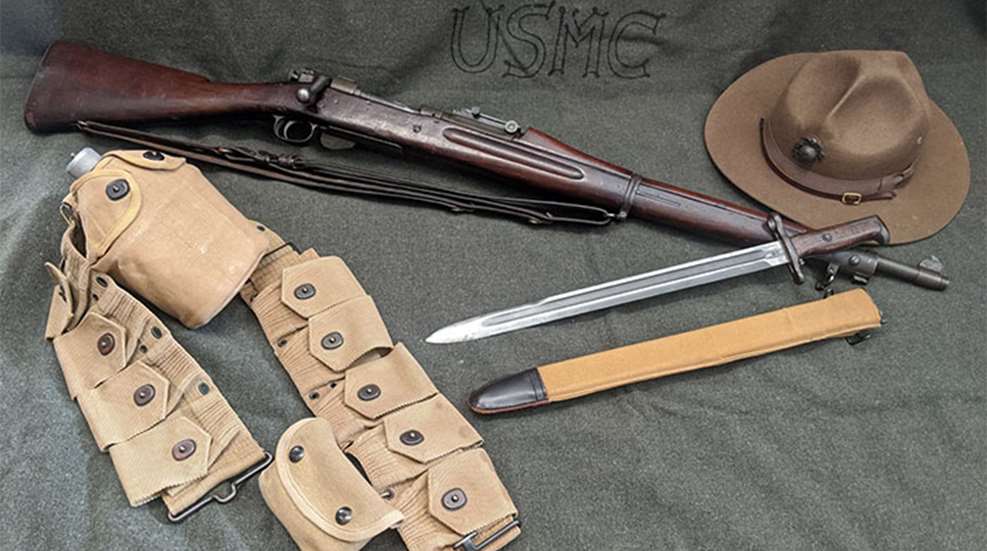
When a historic weapon is displayed, especially one with hard earned wear, dings and dents, the old line “if only it could talk” will surely be uttered at some point. In this instance, United States Rifle, Caliber .30, Model 1903, serial number 325,901 actually can, albeit with a little assistance from archival records. Rifle 325,901 is unique in the way that it can be documented not only to a specific branch of service, but also directly to an individual who carried it for a time.
The rifle itself is what collectors typically consider to be a standard USMC Model 1903 rebuild. It has the classic traits a collector can use to identify a Model 1903 as having lineage to the USMC. This rifle is unusual in that it can be traced to an individual fighting man, telling the researcher which military branch the rifle was assigned to for at least part of its time in service.
Due to the vast number of rifles that went into service with the various components of the U.S. military, it is typically impossible to get much detail about who specifically the rifle served with or where it could have been used. Fortunately, many Model 1903 rifles used by the Marine Corps bear tell-tale marks of their time in service with that branch. While not every rifle will bear every indicator (and parts can always be switched out or fabricated), when taken as a whole they can give a pretty strong idea that the rifle served with the USMC.
This rifle features a number of those classic signs with include:
- A smooth butt plate that has been crudely hand stippled.
- Auxiliary gas escape hole, also known as a “Hatcher Hole”, drilled on the left side of the receiver (these are not solely found on USMC rifles, but the Marines were more consistent in adding them).
- An enlarged gas escape hole drilled into the bolt.
- Vice marks on the barrel from installing barrels in a way apparently peculiar to the Marine Corps and
- A blackened #6 front sight.
Hand Stippled Butt Plate
While the earliest M1903s were produced with smooth butt plates, the military soon settled on a finely checkered design which was in use from about 1910. Production was relatively slow during this period, with less than 600,000 rifles on hand at the start of World War I. This shortage of rifles in April 1917 required weapons to be produced as fast as possible, which was aided by cutting out certain steps like checkering the butts.
The checkering was accomplished by a two-step procedure on a milling machine, one lengthwise and the crosswise. This was something that not only took up a skilled worker but also consumed valuable time. This process was soon eliminated in the interest of expediency, and from mid-1917 through part of 1920 the standard provided butt was smooth.
Because of the huge numbers of weapons produced in response to wartime need, many rifles continued on in service during the inter-war with the smooth butt plate, even after checkering was resumed in 1920. In 1934 the Marine Commandant received complaints that the smooth butt plates were unsatisfactory for rapid fire use, and directed the Marine Quartermaster to make an inquiry about replacing the butt plates with milled examples.
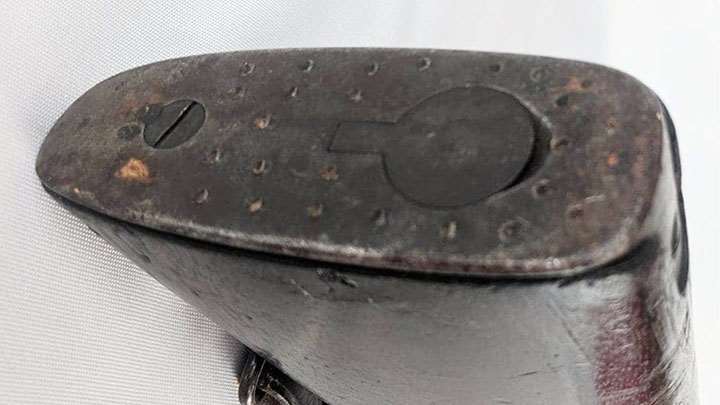
The Quartermaster’s Department in turn wrote a letter to the Commanding Officer of the Springfield Armory requesting information about whether the “knurling” of the butt plates were part of a forging operation, or if they were milled after the forging process. They also asked whether Springfield was remodeling the smooth butt plates into the checkered pattern. Springfield responded by describing the milling process, and also explaining that the wartime smooth butt plates were finished by hand grinding and polishing.
This leaded to a tolerance variation in thickness not permitted on butt plates destined for factory checkering. This, coupled with the fact that the existing smooth butt plates had likely been further polished or recontoured while in service or during overhauls, resulted in an “uneven surface and non-uniform thickness and contour of the old smooth butt plate rear face which would not permit full or uniform checking…” and that “no attempt has been made to check the same.”
While the Marine Corps did do further limited inquiries into conducting their own checkering operations, it seems like a combination of the expense, effort required and likelihood of inconsistent results drove them towards a simpler option. To achieve the same effect as a checkered butt plate, Marine depot personnel at some point began hand stippling smooth butt plates in a variety of different ways. This displaced enough metal to cause a better grip on the shooter’s shoulder, and provides a quick way to identify a possible USMC rebuilt rifle.
Gas Escape Hole Added to Receiver and Enlarged on Bolt
In July 1938 the USMC Quartermaster determined that rifles “broken down and overhauled at the Philadelphia Depot” would be modified with an “additional gas escape hole in the left side of the bolt and receiver.” In doing so they were following the lead of the Army’s Ordnance Department which began doing such modifications during their overhaul process in order to counteract “the large number of split bodies that are being experienced in the firing of the present caliber .30 ammunition.”
The stated function of the extra gas hole was to “provide safety for the firer in that the particles of brass do not escape to the rear through the bolt mechanism but escape through the gas escape hole.” Regardless of whether the hole actually does redirect brass particles, any shooter who suffers a case failure would be happy to have the gas vented sideways, where the most likely danger is a scorched forearm or hand, instead of being funneled directly into their eyes along the bolt.
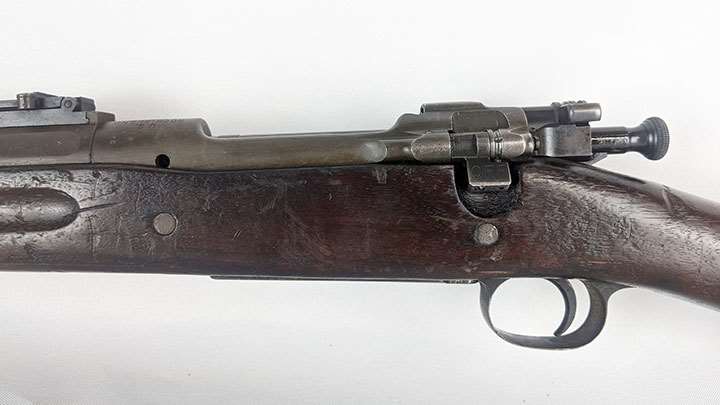
After requesting the appropriate fixtures and drills made at the Springfield Armory for modifying the rifles and bolts, a specialist was then sent to Springfield to learn the method. Chosen for the job was Marine Gunner Stephen J. Zaiga, who was to proceed for approximately three days of temporary duty in Aug. 1938 in order to “observe the procedure required in the modification of the bolt and receiver of the U.S. Rifle, caliber .30, M1903 and M1903A1.” From this lone Marine technician, all the practical know-how of drilling the “Hatcher Hole” flowed to the rest of the Marine Corps, giving him an outsized, but extremely underappreciated, impact on the weapons history of the USMC.
Barrel Vice Marks
Another classic indicator of a Marine re-built rifle is only apparent when the handguard, and sometimes the stock, is removed. The presence of vice marks on the barrels are thought to be nearly exclusive to USMC overhauled rifles, indicating that the Army and Marines used different tools or methods when swapping out barrels. While the authors don’t have any documentary evidence to point to the specific tool used, it seems safe to speculate that the new barrels were held fast in an un-padded vice while the receiver was screwed in place, likely with a proper fitting wrench.
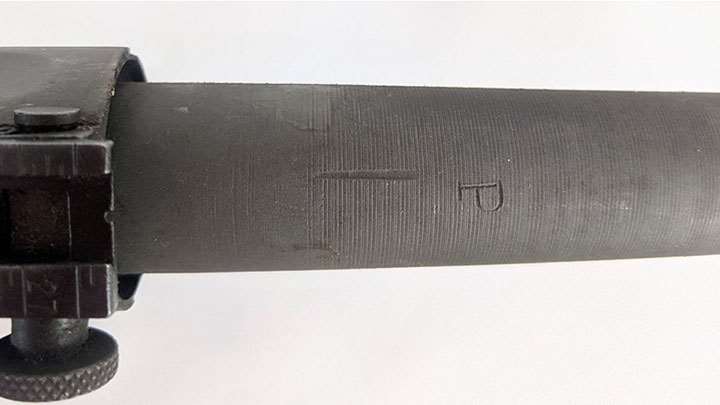
Front Sight
One of the things frequently associated with the Marine Corps is an obsession with marksmanship, something that serves the peacetime military on the rifle range and a wartime military on the battlefield. Towards that end the Marines experimented after World War I with an alternate sighting system for the Model 1903. These were called the #10 sights, a thicker front blade paired against a larger rear peep and surrounded by an enlarged front sight hood.
However, in 1936 it was determined to return to the standard military wide #6 sight and remove the #10’s from all m1903s held by Marine Battalions and those in the fleet. This rifle features a standard #6 front sight, which is appropriate for a rifle rebuilt in the late 1930’s after this order went out. One feature that could help indicate a Marine used rifle, although far from conclusive on its own, is the presence of blackening on the front sight. This old NCO trick helps present a cleaner sight picture free of shine and glare and would surely be taught to young Marines during their initial training, or by the salty long-timers at their first assignment.
A Young Marine, His Rifle, and an Official Investigation
The story this rifle can tell goes deeper than the traits found on the surface, however. Using documents pulled from the National Archives, rifle 325,901 is documented as having been a subject in a Board of Survey conducted at the Marine Barracks in the Washington Naval Yard on Feb. 24, 1938. A Board of Survey was a formal inquiry designed to ascertain the cause of damage or loss to government property, something not too dissimilar from the modern military’s Financial Liability Investigation of Property Loss, or “FLIPL.”
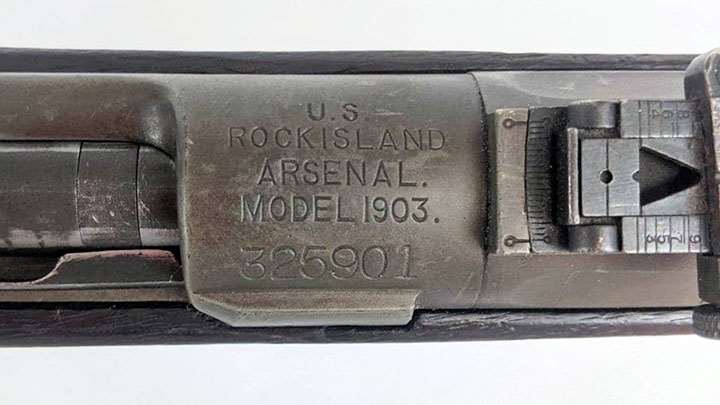
If the cause was determined to be both preventable and attributable to an individual’s negligence or other acts, blame and some degree of financial responsibility would fall on that individual’s shoulders. This particular board was convened to determine if the wear to the bore of rifle 325,901, as well as the bores of the other inquiry subjects, were caused by the carelessness of the marines to which the rifles were assigned.
Fortunately for PFC Mills, the marine responsible for rifle 325,901, the board concluded that the wear was simply the natural result of firing and that he should be relieved from any pecuniary responsibility for the damage. Upon reviewing the muster rolls of the Marine Barracks, it became apparent that only one PFC Mills was stationed at that location when the board was convened.
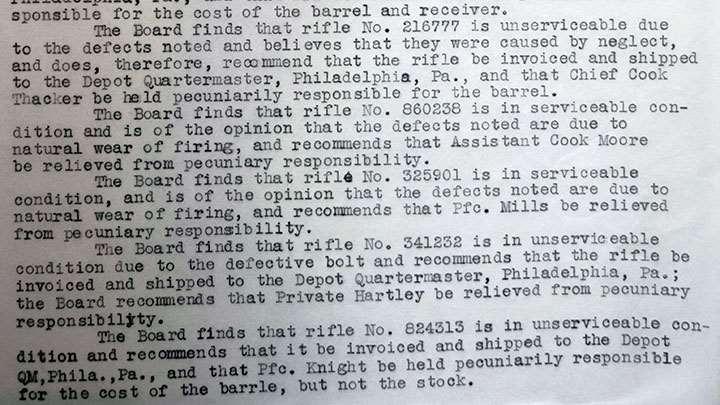
That marine, the man who once proudly carried rifle 325,901 in service to his country, was Kyle Elmer Mills originally from Greeneville, Tenn. Fortunately, the National Archives and Records Administration (NARA) in St. Louis was able to furnish a copy of his personnel file. While tragically a 1973 fire in the National Archives ravaged many World War II era Army personnel records, the USMC documents remained undamaged and available for researchers and family members.
Since it can be traced to an individual Marine, the rifle’s history is now inextricably linked to the person it was once issued to. Unfortunately, Kyle Mills passed away in 1996, but the authors were able to make contact with his daughter, Becki McInturff. Through her contributions, and Mill’s official service records, the authors were able to discover the very personal story about the man behind the rifle.
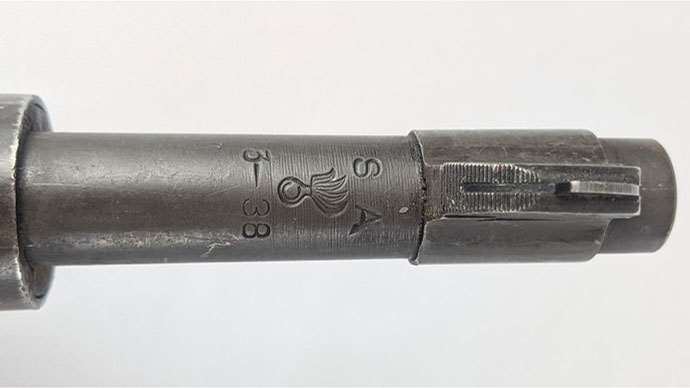
A Two Time Volunteer
Kyle Mills had the distinction of serving his country for two separate periods of time, the first running from 1935 to 1939. During this four-year stint he went to his initial training at Parris Island, before seeing service at various billets stateside and overseas. He was assigned to the highly decorated 2nd Battalion, 5th Marines (2/5), was briefly aboard the USS Reina Mercedes (a former Spanish cruiser captured in 1898) and was one of the “China Marines” stationed in that country to protect American citizens and property during the inter-war years.
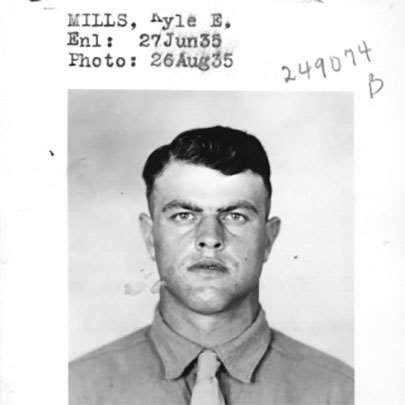
He was promoted to Private First Class on June 10, 1937 and his record during this time was impressively clean for a Marine, with the only recorded infraction being issued during his time aboard the USS Reina Mercedes when he was warned by his commanding officer for accidentally discharging his pistol on July 8, 1937. After his first discharge he worked for the Rustless Iron and Steel Corporation in Baltimore, Md.
When war was declared on Dec. 8, 1941, this work caused him to be classified as a II-B, or “Men necessary to national defense”, in light of the huge demand for manufactured steel products for the war effort. In 1943, Kyle Mills wrote a letter to the Personnel Branch of the USMC requesting his classification be moved from II-B to I-A (available and fit for general military service), stating that he was not trying to stay out of the war. Instead, he wanted to get back into the Marine Corps. His letter is transcribed below:
June 15, 1943
Balt. Md.
Dear Sirs,
I am writing this letter to inquire of the discharge of Kyle Elmer Mills from the Marine Corps Reserve. Fifth Reserve District, Marine Barracks, Norfolk Navy Yard, Portsmouth Va.
Just after my discharge in 1939, the going was rather tough + I changed jobs + addresses pretty often. And once I forgot to write my address in, then a letter came from Norfolk notifying me of the discharge. What I would like to find out is, if there is any way I can reenlist or be reinstated in the Marine Corps. Reserve?
I registered for selective service + have been employed at the Rustless Iron + Steel Corps, 3400 E. Chase Street Balt. Md for the past three years. I wanted to make it clear I am not trying to keep out of the service, on the contrary, I would like very much to be back in the Marine Corp.
I am now in class IIB, the company, doing 100% different work, I am on my third Department, the work is important but I certainly don’t claim to be indispensable. I have tried to enlist + volunteer for induction but they won’t take me unless I am in IA.
I would appreciate it very much if you will give me the information on the discharge + the possibility of my either reenlisting or being reinstated in the Marine Corps Reserve.
Respt-
Kyle Elmer Mills
236 E. 25th Street
Baltimore Md.
His request wasn’t met with immediate acceptance, and a Captain with the USMC Procurement and Enlistment branch wrote a reply stating that he should take up the matter with his local Recruiting and Induction Station. Fortunately, the local recruiting officer believed that his services could be utilized by the USMC as a combat engineer. He completed his course as an engineer on May 27, 1944, and was promoted to Corporal on Sept. 12, 1944.
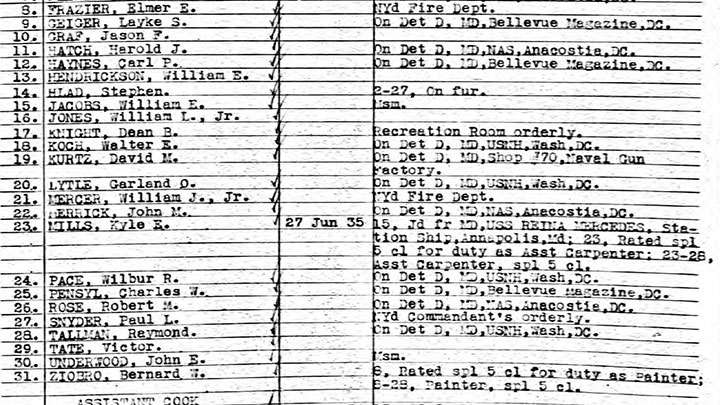
He would then go on to land on Okinawa on Easter Sunday, 1945, as a combat engineer with the 1st Marine Division. The duties of a Marine Corps engineer in such an environment would include utilizing flame throwers and demolitions against hardpoints, as well as providing much needed support to the standard infantrymen. If he was assigned a rifle, by this point he would have been issued a M1 Garand or Carbine instead of M1903 serial number 325,901.
Between his two enlistments he received awards and citations for: Asiatic-Pacific Campaign medal with 1 bronze star, Marine Corps Good Conduct Medal, Presidential Unit Citation Ribbon, World War II Victory Medal, Marine Corps Sharpshooter Pistol Badge, Marine Corps Marksman’s Rifle Badge and the China Service Medal. After the war, Kyle’s daughter Becki McInturff described her father as a brick mason who took pride in his work.
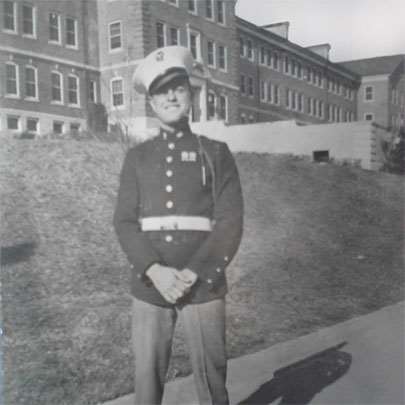
She stated he loved five things most of all: his wife, his daughter, his garden, his cocker spaniels and the Marine Corps. She also described how his laugh would fill up a room, and that he built the house for their family, named Windswept, and treated it as their castle. While late in life he struggled with Alzheimer’s, his fighting spirit and memories of service stayed with him to the end, along with a devoted and strong wife who stood by him until the end.
Despite the many challenges Kyle Mills faced throughout his life he would always rise to the challenge. He was both a devoted husband and father, but also a dedicated Marine that chose to serve on two separate occasions when he was not required to do so. His family to this day looks upon him with the upmost respect and admiration, a sentiment the authors also share. He was buried at Andrew Johnson National Cemetery in Greenville, Tenn. on April 1, 1996, exactly 51 years to the day of the invasion of Okinawa. His weapon, rifle 325,901 lives on in a private collection and will be especially cherished because of its tangible connection to a brave American Marine.












